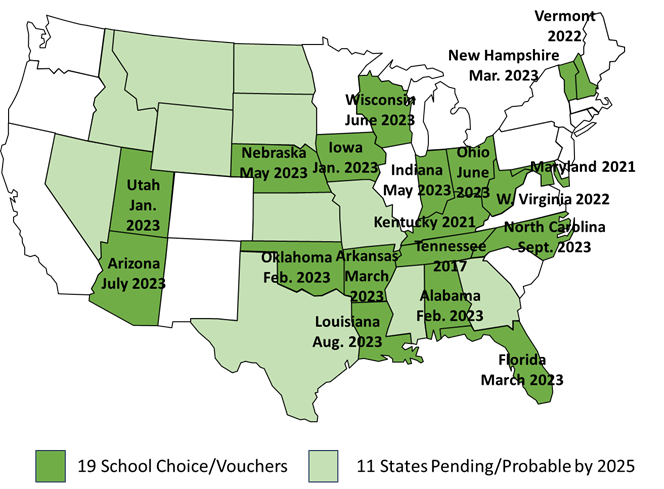School Choice is the number one shift that will subtract students and revenue from traditional public schools. Nineteen States have adopted Choice legislation and most of those have very little restriction. With just those, at least $15 billion can possibly be claimed by vouchers, which is already causing a swarm of new ventures and ingenuity to draw those funds into alternative enterprises. The present Choice States represent thirty-two percent of all K12 students nationally, but the $15 billion estimate is only twenty percent of their public funding because that is roughly the percent of private schooling plus homeschooling. Also, some of those States provide vouchers valued well over the median of $4,600 per student, the median value used to calculate.

What Could Happen
Consider that Mathnasium, which provides local retail math learning personalized to the individual student, is one of the fastest growing franchises in America. Now imagine a sort of learning-Amazon online that also intersects with live gig-economy teachers and on-demand tutors using spatial-temporal AI which accrues out of whole enrollment smaller cohorts of students to designated points of study by their acceptance which indicates pre-work is complete, triggering upon full cohort and firmly setting a meeting on calendars with no additional human hands-on. Thereafter the AI continues to accrue cohorts and calendar until all enrolled are complete through that one meeting. Chained meetings, like a series of classes, all operate with auto-cohorting in between assigned materials to study. Membership in this online store allows access to self-assemble paths of courses which intersect with gig teaching, all with tracking of academic standards through the help of recommendation engines and generative AI. Pre-assessment of learning abilities with ongoing formative assessment could further engage AI customizations. A revolution in homeschooling would spread like wildfire. Now couple all of that with local study lounges and separate meeting spaces which look like classrooms of old, and adult oversight. In that vision you are starting to get the idea that the huge amount of voucher money in the air is going to spawn a lot more than just online options and more private schools. Through AI manipulating time, space, knowledge resources and staffing, new forms will emerge that are not the strict campus-versus-online we have today.
Suffice it to say, the early vouchers going to existing homeschoolers and private schools is just the initial beachhead in a war of attrition soon to spread. There will be many more through the dual attraction of both entrepreneurial money up for grabs and a way to escape anything objectionable in public education.
Were all the States with pending legislation right now to pass new bills in 2024, eleven more would join and put into play at least another $10 billion immediately. The percentage of students eligible would rise to fifty-two percent of our nation’s total.
This new total of twenty-nine States all together spend an estimated $127 billion on public education. That is a massive target to attract brilliant alternatives while bulldozing the past public traditional schooling. All $127 billion will be in play as big and well-branded ideas sweep in to deliver a novel and perfected learning experience that’s not all online and continues to intersect with live teaching and socialization but is flexible and oh-so-personalized.
Education leaders can be certain that the mountain of new legislation adopted changes everything – and not just in those specific States. Pressure will build everywhere. Other States who may be indicating they would “never pass vouchers,” will soon see their dynamics shift because of the overall financial savings. Many of the existing States spend less than half of their regular per-pupil spend and one-third their total public funding per pupil on the actual vouchers. Savings in the hundreds of billions is no joke for cash-strapped States who could do as others have done and tout legislative change as a boon while privately hoping to trim budget by great orders of magnitude.
Conversely, public education could itself transform. With new forms of schooling emerging like hybrid logistics, there is a high probability that citizen demand will skyrocket for schools offering so much flexibility and personalization. Public education could also find itself disaggregating it’s monolithic service structure and offer elements such as pathway planning to homeschoolers and more, taking whatever pieces they can still hold on to.
***










